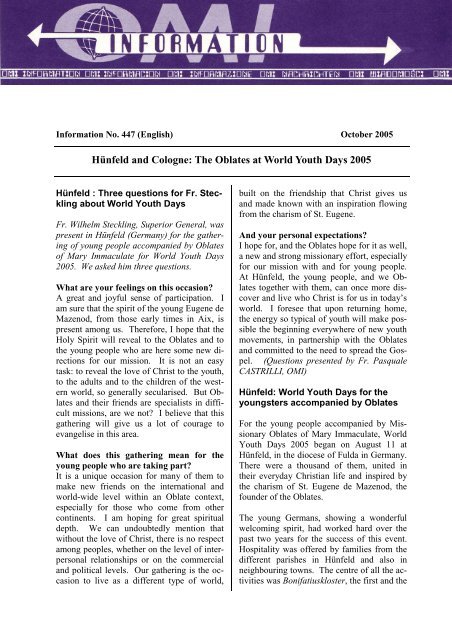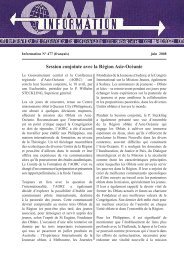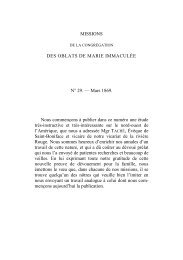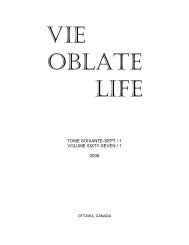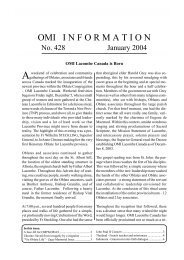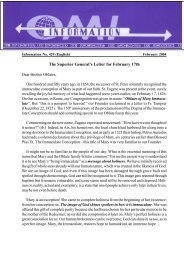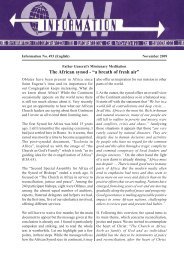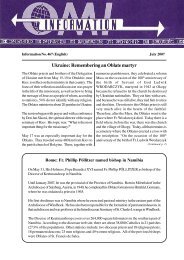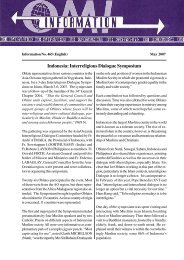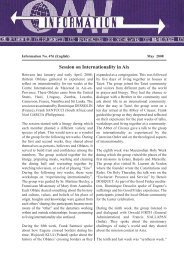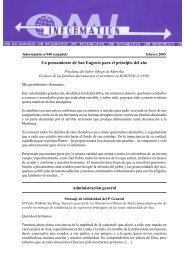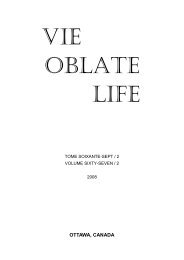Oct. 2005 - OMI World
Oct. 2005 - OMI World
Oct. 2005 - OMI World
You also want an ePaper? Increase the reach of your titles
YUMPU automatically turns print PDFs into web optimized ePapers that Google loves.
<strong>Oct</strong>ober <strong>2005</strong> 447/1<br />
Information No. 447 (English) <strong>Oct</strong>ober <strong>2005</strong><br />
Hünfeld and Cologne: The Oblates at <strong>World</strong> Youth Days <strong>2005</strong><br />
Hünfeld : Three questions for Fr. Steckling<br />
about <strong>World</strong> Youth Days<br />
Fr. Wilhelm Steckling, Superior General, was<br />
present in Hünfeld (Germany) for the gathering<br />
of young people accompanied by Oblates<br />
of Mary Immaculate for <strong>World</strong> Youth Days<br />
<strong>2005</strong>. We asked him three questions.<br />
What are your feelings on this occasion<br />
A great and joyful sense of participation. I<br />
am sure that the spirit of the young Eugene de<br />
Mazenod, from those early times in Aix, is<br />
present among us. Therefore, I hope that the<br />
Holy Spirit will reveal to the Oblates and to<br />
the young people who are here some new directions<br />
for our mission. It is not an easy<br />
task: to reveal the love of Christ to the youth,<br />
to the adults and to the children of the western<br />
world, so generally secularised. But Oblates<br />
and their friends are specialists in difficult<br />
missions, are we not I believe that this<br />
gathering will give us a lot of courage to<br />
evangelise in this area.<br />
What does this gathering mean for the<br />
young people who are taking part<br />
It is a unique occasion for many of them to<br />
make new friends on the international and<br />
world-wide level within an Oblate context,<br />
especially for those who come from other<br />
continents. I am hoping for great spiritual<br />
depth. We can undoubtedly mention that<br />
without the love of Christ, there is no respect<br />
among peoples, whether on the level of interpersonal<br />
relationships or on the commercial<br />
and political levels. Our gathering is the occasion<br />
to live as a different type of world,<br />
built on the friendship that Christ gives us<br />
and made known with an inspiration flowing<br />
from the charism of St. Eugene.<br />
And your personal expectations<br />
I hope for, and the Oblates hope for it as well,<br />
a new and strong missionary effort, especially<br />
for our mission with and for young people.<br />
At Hünfeld, the young people, and we Oblates<br />
together with them, can once more discover<br />
and live who Christ is for us in today’s<br />
world. I foresee that upon returning home,<br />
the energy so typical of youth will make possible<br />
the beginning everywhere of new youth<br />
movements, in partnership with the Oblates<br />
and committed to the need to spread the Gospel.<br />
(Questions presented by Fr. Pasquale<br />
CASTRILLI, <strong>OMI</strong>)<br />
Hünfeld: <strong>World</strong> Youth Days for the<br />
youngsters accompanied by Oblates<br />
For the young people accompanied by Missionary<br />
Oblates of Mary Immaculate, <strong>World</strong><br />
Youth Days <strong>2005</strong> began on August 11 at<br />
Hünfeld, in the diocese of Fulda in Germany.<br />
There were a thousand of them, united in<br />
their everyday Christian life and inspired by<br />
the charism of St. Eugene de Mazenod, the<br />
founder of the Oblates.<br />
The young Germans, showing a wonderful<br />
welcoming spirit, had worked hard over the<br />
past two years for the success of this event.<br />
Hospitality was offered by families from the<br />
different parishes in Hünfeld and also in<br />
neighbouring towns. The centre of all the activities<br />
was Bonifatiuskloster, the first and the
447/2 <strong>Oct</strong>ober <strong>2005</strong><br />
oldest Oblate house in Germany, constructed<br />
more than a hundred years ago.<br />
One had the impression that during these<br />
days, everything became a vast mission, not<br />
only an opportunity for gathering but also for<br />
spreading the Gospel.<br />
On the first day, after the welcome by Father<br />
Thomas KOSTERKAMP, provincial of Germany,<br />
by the bishop of Fulda, by the mayor<br />
of Hünfeld, and by Fr. Wilhelm STECK-<br />
LING, Superior General, all of the groups<br />
were introduced. The Italians and Germans<br />
were the most numerous. There was also a<br />
strong presence of Poles, Australians, French<br />
and Spanish, but also youth from Canada,<br />
Chile, Argentina, Sri Lanka, and Turkmenistan.<br />
It was a real feast of nations.<br />
That first day, marked by the typical enthusiasm<br />
of any youth gathering, concluded with a<br />
prayer vigil around the cross in the church of<br />
the Oblate community at Bonifatiuskloster.<br />
On the other hand, because of bad weather,<br />
the big sound and light show, scheduled for<br />
August 12, had to be postponed. (Gianluca<br />
Rizzaro)<br />
Hünfeld and Cologne: A Roman scholastic’s<br />
<strong>World</strong> Youth Days Experience<br />
Three members of the International Scholasticate<br />
community in Rome recently accompanied<br />
a large group of young Italians to <strong>World</strong><br />
Youth Day in Germany (Roshan FER-<br />
NANDO, Ross KAPUNAN, and Asanga<br />
LIGANGE). Brother Asanga gives us here<br />
some of his personal reflections about their<br />
pilgrimage.<br />
I was once again richly blessed by our Good<br />
God because He added another unique and<br />
wonderful experience to my life when I participated<br />
in the 20th <strong>World</strong> Youth Days in<br />
Germany. I would say simply that it was a<br />
faith experience and a journey towards God<br />
with young people.<br />
Hünfeld. I should give full credit to the Oblates<br />
because they have done a perfect job.<br />
My experience in Hünfeld was really remarkable.<br />
I lived in a family. They were very nice<br />
and I enjoyed the family life and German<br />
hospitality. I became one of them so much so<br />
that when I left them, we were all in tears. In<br />
Hünfeld I was able to pray, eat and enjoy<br />
with my group members. We were a faith<br />
sharing community. Although we were from<br />
different places, we had one thing in common--our<br />
faith in the living God. We were<br />
no longer foreigners.<br />
Then from Hünfeld, we went to Köln to continue<br />
the second step of the <strong>World</strong> Youth<br />
Days programme. I was one among hundreds<br />
of thousands of young people. I had had the<br />
impression that modern day youth were turning<br />
away from God. But I had to change my<br />
opinion because I was witnessing the reality.<br />
So many youth from all over the world<br />
prayed and shared their faith experience together.<br />
What I noticed was that the Church<br />
still lives among the young people; they love<br />
the Church and Jesus.<br />
Jesus is no longer a stranger. Instead He is a<br />
friend who understands and journeys with<br />
young people in their own day to day struggles.<br />
There were long lines to receive the sacrament<br />
of reconciliation and chapels reserved<br />
for Eucharistic adoration were always filled<br />
with youngsters.<br />
As young people, we were ready to accept<br />
bad weather, but God gave good weather. We<br />
all together worshiped our Lord just as the<br />
three Wise Men came from the Far East to<br />
adore the Lord.<br />
As I return to the eternal city and to the International<br />
Scholasticate, I can say that our<br />
Church is a young Church and that God is<br />
present even more radically than the past<br />
among youngsters because they have found<br />
him in their search.<br />
First we had our Oblate youth gathering at
<strong>Oct</strong>ober <strong>2005</strong> 447/3<br />
Europe<br />
ANGLO-IRISH<br />
The Birmingham Bullring and Secular<br />
Culture<br />
Pawel RATAJCZAK, one of the Oblates on the<br />
Mission to Secularity team in Birmingham, England,<br />
reflects on a shopping complex that has become,<br />
in some sense, a “cathedral of secularity”<br />
for many of those who pass through it.<br />
The Bullring, a large shopping complex located<br />
in the city centre of Birmingham encompasses<br />
an entire district in the city. More<br />
than just a shopping mall, the Bullring is a<br />
place of encounter and energy. It is a symbol of<br />
regeneration, of a new Birmingham that is<br />
moving beyond its past of red-brick factories.<br />
I would like to use the Bullring as a point of<br />
reference in my reflection on secular culture.<br />
Almost every day I walk from the Oblate residence<br />
at St. Anne's parish to St. Michael's in<br />
the city centre. My stride takes me into the<br />
Bullring, past the multicoloured displays,<br />
food stalls, and throngs of shoppers milling<br />
about. There is the conspicuous presence of<br />
teenagers, a group that is often underrepresented<br />
in our two parishes. I wish that<br />
these young men and women would make a<br />
commitment to Christian community a<br />
regular part of their lives. Yet the Bullring<br />
attracts the youth everyday of the year. The<br />
kaleidoscope of images, store displays, and interesting<br />
architecture all play a part in making<br />
this shopping complex an alluring place.<br />
There is always something happening in the<br />
Bullring; the energy never stops. Monitors display<br />
the latest news from around the world, and<br />
people continuously mill around, whether<br />
they’re shopping, eating, waiting for their<br />
bus, or simply sitting down and watching others.<br />
The Bullring is where people come to lose<br />
themselves, even if just for a while. It is a<br />
place where ordinary life stops, and supercharged<br />
consumer reality begins.<br />
I think the Bullring reflects secular culture<br />
in many ways. It is full of energy, life, and vitality.<br />
Advertising budgets make it an interesting<br />
location, with the decorations changing<br />
seasonally--almost like the Church’s liturgical<br />
year. Also, the Bullring is a place of<br />
encounter: it is where people gather. There are<br />
high school students enjoying a pizza; trendy<br />
business people looking for new clothes at the<br />
ritzy Selfridge's department store; and retirees<br />
doing food shopping--these all find common<br />
ground at the Bullring. Much like secular<br />
culture, the Bullring does not require commitment:<br />
shoppers arrive and depart at their<br />
liking, without any obligation. Allegiance to a<br />
particular store can easily change when<br />
prices drop at a competitor's location.<br />
Yet the Bullring's supercharged consumer reality<br />
does not last long. Young people have to<br />
go home, back to families, parents, and the<br />
stresses of adolescent life. Business people<br />
have to leave the Bullring to face the rivalries<br />
of the workplace. Retirees need to return<br />
to their apartments, where they often live<br />
alone. The Bullring is only a part of life, and<br />
not its sum total. Even supercharged consumer<br />
reality is not immune from the joys<br />
and sorrows of human existence.<br />
Secular culture and the Bullring are not built<br />
on principles that last through millennia; by<br />
themselves, consumer reality and other aspects<br />
of secularity would not last through persecution<br />
or extended hardship. People would<br />
not offer up their lives for a chance to go<br />
shopping, even in the alluring Bullring. In<br />
addition, without God, secular culture can<br />
turn on itself, and show appalling disregard for<br />
human life--we need only to look at the<br />
plight of unborn children, and the fate of<br />
people like Terri Schiavo to confirm such an<br />
attitude.<br />
This is why the Church’s message of encounter<br />
with Jesus Christ is still indispensable<br />
to the people milling about the Bullrings of
447/4 <strong>Oct</strong>ober <strong>2005</strong><br />
today. Christ offers grounding for life that<br />
will never be out of style like some passing<br />
fad: a grounding that will last. As the prophet<br />
Isaiah says, "Why do you spend your money for<br />
that which is not bread, and your labour for<br />
that which does not satisfy" To engage in today’s<br />
consumer society people need money.<br />
Christ’s message, on the other hand, is free, so<br />
that everyone, even the poor, can fully participate.<br />
Finally, Christ, and the message he<br />
brings, respects the dignity of all human life,<br />
whether weak or strong.<br />
As I walk to St. Michael's, our city-centre parish,<br />
I pass through the crowds of the Bullring.<br />
I often wrack my brains trying to find out<br />
how we, the Oblates ministering to secular<br />
culture, will reach these people. I am certain,<br />
however, that the message of Christ, the<br />
Risen One, is urgently needed in secular society<br />
and the many Bullrings of today.<br />
FRANCE-BENELUX<br />
Polish biography of Józef Cebula<br />
Five years ago, Fr. Józef PIELORZ wrote a<br />
biography of Blessed Józef Cebula that was<br />
published in French as volume six of the collection<br />
Oblate Writings II, and translated into<br />
English the following year. With the help of<br />
Fr. Jan CHMIST, he has now translated it<br />
into Polish. Fr. Alphonse KUPKA has provided<br />
illustrations.<br />
The author and now translator says that the<br />
Polish version differs a bit from the French. It<br />
has been corrected and completed by the discovery<br />
of new documents. Some passages,<br />
which were judged to be superfluous, have<br />
been removed. This Polish version, says Fr.<br />
Pielorz, is the one that is closest to the facts<br />
of history as we know them today.<br />
Africa-Madagascar<br />
MADAGASCAR<br />
25th anniversary of missionary presence<br />
This year of <strong>2005</strong> marks an important event<br />
in the life of the Missionary Oblates of Mary<br />
Immaculate in Madagascar. They are celebrating<br />
the 25 th Anniversary of their establishment<br />
in the Diocese of Tamatave.<br />
03 December 1980—03 December <strong>2005</strong><br />
Twenty-five years of presence among the<br />
poor. It has been a presence that is characterized<br />
by missionary involvement in all of the<br />
various aspects of life’s realities in a place<br />
where the first thing that strikes one is poverty.<br />
It is material poverty, although not destitution,<br />
yet a poverty that lets shine through a<br />
human wealth that bursts forth in a spirit of<br />
welcome, of sharing, and of availability.<br />
Another ever-present and dominating reality<br />
is ancestor worship. It is a practice that is<br />
very ceremonial, communitarian, and deeply<br />
anchored in the Malagasy soul. The life of<br />
the individual is always tied to different ancestral<br />
customs. Thus the question arises:<br />
how to preach the Good News of the Salvation<br />
wrought by Jesus Christ to a people who<br />
are so sure of having a permanent contact<br />
with the “beyond” simply by carrying out a<br />
certain number of very special rituals What<br />
is the future for these “primitive people” who<br />
are being confronted with globalisation,<br />
where technology, productivity, and instant<br />
success rule the day Is it already too late to<br />
prepare them for world-wide civilization that<br />
is already crushing them How can they<br />
avoid being railroaded by a progress that is<br />
perceived rather as “having more” than as<br />
“being better”<br />
The answers we bring are only drops of water<br />
that do not comprise an ocean, because in<br />
Madagascar, as in Africa, they evaporate before<br />
reaching any depth. There are realities<br />
that shout of social injustice, both in the rural<br />
areas and in the cities: very needy families;<br />
the elderly without any resources; young people<br />
who have no guidance; sick people who
<strong>Oct</strong>ober <strong>2005</strong> 447/5<br />
have no money for treatment, etc. In a word,<br />
the people of God are bleeding!<br />
The passion of Christ shows itself on many<br />
faces here. It is not the world turned upsidedown,<br />
but it is the world of today calling us<br />
to be witnesses of the presence of the Church<br />
among the poor. When the Congregation of<br />
the Missionary Oblates of Mary Immaculate<br />
arrived in Madagascar, twenty-five years ago,<br />
this reality required of them many adjustments,<br />
sacrifices, and conversions.<br />
The Mission: to evangelise the poor<br />
It is this choice that persuaded some Polish<br />
priests of the Congregation of the Missionary<br />
Oblates of Mary Immaculate to settle in<br />
Madagascar twenty-five years ago.<br />
With its nearly fifteen million inhabitants,<br />
Madagascar is one of the largest islands in<br />
the world. Separated from Africa by the Mozambique<br />
channel, it is among the poorest nations<br />
in the world. The level of life hovers<br />
over the brink of poverty. The national economy,<br />
while claiming to be based on agriculture<br />
and raising livestock, has actually deteriorated<br />
after forty years of indecision and<br />
confusion. Nevertheless, today the country is<br />
involved in a new search for its cultural identity<br />
after the political crises of 2002. All the<br />
same, the striking situation mentioned above<br />
gave shape to the choices the Oblates made<br />
upon arriving in Madagascar.<br />
1°) --To go and establish roots in places that<br />
were hardest to reach, isolated places where<br />
there are no roads and where poverty undermines<br />
the value of the human person. Thus,<br />
their missionary choice centred on the southern<br />
part of the diocese of Taomasina:<br />
MAROLAMBO, located about 400 km.<br />
from the seat of the diocese, is one of the<br />
most remote sub-prefectures. For the Territorial<br />
Administration, this is where they<br />
send unmanageable officials to be disciplined<br />
because it is a place cut off from all<br />
contact with the rest of the country. Today,<br />
there are still adults in this region<br />
who have never seen a car. It is there that<br />
the pioneer Missionary Oblates of Mary<br />
Immaculate landed on 03 December 1980.<br />
AMBINANINDRANO, located 60 km.<br />
before arriving at Marolambo, was chosen<br />
at the same time to serve as a place where<br />
the missionaries could get together.<br />
MAHANORO is the prefecture whence<br />
things spread out to the surrounding regions.<br />
The possibility and the means of<br />
communication are more convenient there.<br />
It is there that in 1986 the first Oblate settled<br />
in to better serve the other centres of<br />
the mission. That permitted the establishment<br />
of the mission of MASOMELOKA.<br />
2°) –To go and establish roots in the abandoned<br />
neighbourhoods and in the poorest<br />
places in the city.<br />
In 1988, the Oblates took charge of the Parish<br />
of Notre Dame de Lourdes in Toamasina.<br />
Then, in the context of the celebration of the<br />
Jubilee Year 2000, the Oblates built a new<br />
parish church, Saint Eugene de Mazenod, at<br />
Fianarantsoa. The presence in an urban setting<br />
helped increase their missionary involvement:<br />
the Oblates assumed various chaplaincies<br />
such as a prison, a hospital, a university,<br />
as well as the creation and the management<br />
of an audiovisual centre, <strong>OMI</strong>FILM, at Fianarantsoa.<br />
Most recently, they took on<br />
maritime ministry as part of the Apostleship<br />
of the Sea.<br />
A better tomorrow<br />
Aware of the increased difficulties in the<br />
lives of the people and being daily confronted<br />
with families in distress, the Oblates in<br />
Madagascar opted for a new form of pastoral<br />
and missionary work. They became aware of<br />
a three-faceted poverty: spiritual, moral, and<br />
material.<br />
It is difficult to preach the Gospel to people<br />
who are hungry! And we are there, not to<br />
give them something to eat, but rather to help<br />
them stand on their own feet and take charge<br />
of their own future. In other words, we wish<br />
to give them confidence in themselves to de-
447/6 <strong>Oct</strong>ober <strong>2005</strong><br />
velop their own interior resources and possibilities,<br />
while drawing their strength from the<br />
infinite love of God through his Son Jesus<br />
Christ, in the unity of the Holy Spirit. That is<br />
our missionary work.<br />
But if one begins, one needs also to persevere.<br />
The wish expressed in 1988 by the superior<br />
general, Fr. Marcello ZAGO, <strong>OMI</strong>, became<br />
reality one year later with the opening<br />
of the novitiate in Ambinanindrano. This led<br />
to the opening, in 1992, of the scholasticate<br />
in Antananarivo (now transferred to Fianarantsoa)<br />
and in 1996, the pre-novitiate in<br />
Toamasina.<br />
Today, more than 10 Malagasies have finished<br />
formation and are now Missionary Oblates<br />
of Mary Immaculate.<br />
Twenty-five years of Oblate presence in<br />
Madagascar! This event must not pass unnoticed,<br />
especially for Madagascar, because<br />
many have collaborated to maintain it and<br />
help it so that this presence could become a<br />
reality.<br />
•The Malagasies themselves who saw the importance<br />
of our involvement.<br />
•Τhe Oblates of Mary Immaculate from different<br />
countries.<br />
•The organizations and benefactors who<br />
helped in different ways.<br />
Through the celebration of this 25 th Anniversary,<br />
the Delegation of the Missionary Oblates<br />
of Mary Immaculate in Madagascar<br />
wants to strengthen their missionary work.<br />
But, even more, they count on the prayers of<br />
all so that the church might move forward,<br />
continuing the words of Christ: Whatever you<br />
did for the least of my brothers or sisters, you<br />
did it for me.<br />
BOTSWANA<br />
First problem solved, happiness obtained!<br />
Upon celebrating the first anniversary of his<br />
ministry in Botswana, Fr. Michael KHOTSO,<br />
from the province of Lesotho, reflects upon<br />
the surprises, the difficulties, the challenges,<br />
and the joys of his first year in this Oblate<br />
mission.<br />
On June 5, <strong>2005</strong>, I celebrated the first anniversary<br />
of my arrival in Botswana as a missionary.<br />
To make it even more interesting,<br />
April 17 was the first anniversary of my ordination<br />
to the priesthood. You can imagine<br />
what a celebration it was! Since June 5 was<br />
on a Sunday, the Christians were there to add<br />
spice and flavour.<br />
I am slowly getting used to our mission here.<br />
For example, when I first arrived here, I was<br />
discouraged by the apparently insignificant<br />
number of people coming for church services,<br />
especially in the outstations. I would travel<br />
for 120 km only to find 5 people. This did<br />
not go down well with me. But closely looking<br />
at our situation here, I realized that the<br />
country is big and the people are scattered all<br />
over. The villages are small. Therefore, I<br />
should not always expect full-house. First<br />
problem solved, happiness obtained!<br />
I am still struggling with the language, although<br />
there is notable progress. Now I understand<br />
much better than before. The problem<br />
is speaking correctly! The closeness of<br />
Setswana to Sesotho is not helping my course<br />
at all.<br />
But I hope, with time I will get better and better.<br />
Another thing I have become aware of is that<br />
I grew up in a certain way which shaped me<br />
and made me see and judge things in a certain<br />
way. I don’t know whether to call these cultural<br />
values or beliefs. These elements are<br />
challenged when one moves from one community<br />
to another. The challenge is to grow<br />
beyond these cultural practices and beliefs<br />
and not to judge other people basing myself<br />
on such elements. And this can be very difficult<br />
sometimes!<br />
Finally, I have also realized that I have to<br />
open up, be ready to learn, and allow these<br />
people to enrich me with their innumerable<br />
values and gifts. All in all, I feel happy and I<br />
am looking forward to enjoying even further<br />
my stay and missionary activity here in Botswana.
<strong>Oct</strong>ober <strong>2005</strong> 447/7<br />
Latin America<br />
BOLIVIA<br />
Month-long preparation retreat for perpetual<br />
vows<br />
From July 1-29, 17 young Oblates from the<br />
Latin American Region took part in a silent<br />
Oblate retreat to prepare themselves for their<br />
perpetual oblation in the Congregation. The<br />
retreat took place at the retreat house of the<br />
Marist Brothers in Santa Cruz, Bolivia. The<br />
young Oblates came from 7 countries: Brazil<br />
(5), Peru (3), Haiti (3), Colombia (2), Paraguay<br />
(2), Chile (1), and Bolivia (1). Haiti<br />
was participating for the first time.<br />
The team of presenters was made up of five<br />
formators from the scholasticates: Francisco<br />
RUEAUX (Brazil), Alberto HUAMÁN<br />
(Peru), Ariel MARTINEZ (Mexico), Pedro<br />
BRITEZ and Leo GUILMETTE (both from<br />
Paraguay.)<br />
The retreat is sponsored by the CIAL. It has<br />
taken place every two years since 1999. In<br />
the four retreats since that year, a total of 73<br />
young Oblates have participated.<br />
In spite of the effort that a month-long silent<br />
retreat demands, the results have been very<br />
positive. Plans are to continue the program<br />
every two years.<br />
“It is a unique experience, an opportunity to<br />
deepen your Oblate vocation. Don’t miss it<br />
for anything!” That was the answer given by<br />
one of the participants when asked how he<br />
would respond to a friend who was thinking<br />
of taking part in a future retreat.<br />
BRAZIL<br />
Mission in Manaus<br />
When four Oblates arrived in the capital of<br />
the State of Amazonas last February, they began<br />
to work in two large “missionary areas”<br />
on the edge of the eastern zone of the city of<br />
Manaus. It is the most populous and the least<br />
organized part of the capital, near the Industrial<br />
District with more than 500 factories.<br />
The team is made up of Peter CURRAN,<br />
Pedro PAULO, Ednaldo TAVARES DE<br />
SILVA and William REINHARD.<br />
Just to give an idea of the population explosion<br />
in the capital, in 1970 there were<br />
250,000 inhabitants in the city, and now there<br />
are almost 1,800,000. Of this number, more<br />
or less 80% of them live in the precarious periphery,<br />
without an infrastructure, without basic<br />
sanitation, without almost anything. It is<br />
a series of land occupations creating urban<br />
chaos. It is as if the public officials threw up<br />
their hands and said “Let’s see if the people<br />
can turn it around.”<br />
And the people, in their wisdom, are turning<br />
it around, building their shacks near the<br />
streams and stringing improvised electric<br />
power lines from one shack to another.<br />
Many have come from the interior of the<br />
state, from the northeast, from all over, drawn<br />
by the dream of easily finding work here and<br />
by the fantasy of better living conditions. But<br />
the jobs are filled already, while immigration<br />
continues day after day, with no controls.<br />
They go out looking for new jobs on the land,<br />
cutting into the jungles, and no one does anything<br />
about it. Or almost no one, for the<br />
Church is there, quietly, yet there, nevertheless.<br />
We have two teams of missionaries, living<br />
and working in different barrios, but dining<br />
together every day. Thus we create an Oblate<br />
missionary community.<br />
Pedro Paulo and Peter Curran take care of a<br />
“missionary area” called Grande Victória<br />
with 50,000 inhabitants in five small communities<br />
established in recent years. This includes<br />
an enormous occupied area of 20,000<br />
people who arrived a year ago. The team is<br />
organizing these people into five smaller<br />
groups.<br />
Ednaldo and Bill live and work in an area
447/8 <strong>Oct</strong>ober <strong>2005</strong><br />
called Tancredo Neves, some kilometres<br />
away. This area began 18 years ago and today<br />
has 70,000 residents. There are 7 communities,<br />
each with its chapel and small<br />
group of faithful, its Ministers of the Word,<br />
Ministers of the Eucharist, etc. These people<br />
have a traditional faith with many devotions,<br />
but without much formation and without a<br />
more inclusive vision of the Church as the<br />
People of God living in the world and engaged<br />
in it.<br />
Our work thus far has been to accompany this<br />
welcoming and suffering people, trying to listen<br />
to their cries and to their worries. We began<br />
by visiting the sick and elderly, those<br />
who cannot come to the church. We are visiting<br />
the leaders, the coordinators and the animators<br />
of the various existing ministries.<br />
Through this initial contact, we are slowly<br />
learning the local culture and winning their<br />
confidence. We are also starting bible study<br />
groups in the homes of the various communities.<br />
And finally we are celebrating the<br />
Eucharist monthly in each community and<br />
periodically baptizing the children. During<br />
these years, they have never had a resident<br />
priest, only some religious of various orders<br />
who would come every so often.<br />
Continuity and consistency were lacking because<br />
each visiting priest was orienting the<br />
people according to his own culture, spirituality<br />
and pastoral focus. In fact, the person<br />
who left the greatest impression on the people<br />
was an Augustinian sister who was greatly<br />
dedicated and greatly loved by all, and who<br />
worked with the people for the past 10 years.<br />
The result of all this is that the people are<br />
theologically confused, pastorally wanting,<br />
and also dependent, in great part, on clergy<br />
from outside. This is the greatest challenge<br />
that we are facing here.<br />
On May 23, we celebrated our first Oblate<br />
Day in Manaus in the yard of a neighbour.<br />
We began with a prayer and then we reflected<br />
on our pastoral and Oblate experiences in<br />
these first three months. We closed with a<br />
simple and beautiful Eucharist presided by<br />
Pedro Paulo who was celebrating one year of<br />
perpetual vows. And of course there was a<br />
festive meal.<br />
There was consensus about the fact that our<br />
experience had begun well and has been very<br />
rewarding for each of us. We decided to continue<br />
our visits, our bible groups and the accompaniment<br />
of the small groups. Beyond<br />
that, we are gradually taking on more things.<br />
Pedro Paulo is already visiting a big hospital<br />
in the city’s downtown twice a week. Peter<br />
Curran is beginning a bible study for the<br />
leaders of the area. Ednaldo is accompanying<br />
the reflections of the CRB and guiding the<br />
formation of Ministers of the Word in his<br />
area. Bill is taking part in the meetings of the<br />
Social Ministry of the archdiocese. Pedro<br />
Curran and Bill are soon going to help out a<br />
bit in the School of Faith and Politics in the<br />
second semester.<br />
All four, in response to the call of the bishops,<br />
are helping with Masses in the city of<br />
Manaquiri, 50 km. from Manaus. That parish<br />
has a main church and 33 communities.<br />
There is a permanent team of six religious<br />
women taking care of the area.<br />
We ask for your prayers that we might be<br />
able to respond with consistency to our missionary<br />
charism. (Nossas Notícias, June<br />
<strong>2005</strong>)<br />
Asia-Oceania<br />
SRI LANKA<br />
Recovering from the tsunami<br />
While the devastating tsunami that took the<br />
lives of tens of thousands on 26 December<br />
2004 is no longer a front-page item in the media,<br />
nevertheless, those who survived the disaster<br />
continue to go about the daunting task<br />
of rebuilding their lives and their homes.
<strong>Oct</strong>ober <strong>2005</strong> 447/9<br />
The newly appointed Oblate provincial of the<br />
Colombo province in Sri Lanka, Fr. Clement<br />
WAIDYASEKARA, has been involved in a<br />
joint effort in the city of Batticaloa, along<br />
with Jesuit Fr. Gabriel Alfred, Redemptorist<br />
Fr. Shanthi Abeysingha, and the Rotary Club<br />
of Kandy in aiding those who live in St.<br />
Sebastian Parish, Puliyadikudah.<br />
Upon visiting the ravaged area, it quickly became<br />
obvious that any action plan to help the<br />
residents had to come from the people themselves.<br />
Tsunami Rehabilitation Committees<br />
were established BY the people and FOR the<br />
people, with a cross-section of society represented<br />
in the committees themselves. The<br />
suggestions of the people were practical and<br />
down-to-earth.<br />
Some of the principal aspects of the Action<br />
Plan involved the following:<br />
Provision of Relief Items: cooked food,<br />
clothes, medicine, candles, matches, mosquito<br />
coils, mats, toys and soothers for the<br />
little children, etc., as well as dry rations,<br />
cooking utensils, buckets, and clothes. There<br />
was also the important service of offering<br />
comfort to the bereaved and praying with<br />
them.<br />
School Books were distributed along with<br />
pencils, erasers, mathematical instrument<br />
boxes, school bags, uniform materials, etc.<br />
House Reconstruction: About 170 houses<br />
were identified for reconstruction. Each<br />
committee has identified ten houses in each<br />
area and the owners are being provided with<br />
building materials. Labour is contributed by<br />
local carpenters, etc. This method enables<br />
the affected victims to come back home, to an<br />
area of about 250 square feet, and start life<br />
anew.<br />
Self-Help/Income-generating Project. Many<br />
of the victims are carpenters, masons, auto<br />
mechanics, or business people and many are<br />
self-employed. They have lost all their tools<br />
and equipment. 450 fishermen have suffered<br />
due to the onslaught of the tsunami. 350 of<br />
them are hired fishermen working for about<br />
100 boat owners. These boat owners have<br />
lost their boats and nets. Therefore, the committees<br />
offer a one-time grant to purchase<br />
boats and nets so that the other fishermen can<br />
get back to their normal work.<br />
From the extent of the disaster, it is obvious<br />
that it will be many months and even years<br />
before life returns to some semblance of normality<br />
for the surviving victims of the tsunami.<br />
Canada-United States<br />
CANADA<br />
An Oblate on the streets<br />
Oblate Father Jules CLOUÂTRE works with<br />
“street kids.” He is part of a team sent out<br />
by Pop’s, an organization whose purpose is<br />
to help homeless youngsters (ages 15-19). Its<br />
official title is Le Bon Dieu dans la Rue (The<br />
Good God on the Street).<br />
Every day he comes face to face with human<br />
misery in its purest form. “We work under<br />
pressure. The kids come with all their suffering.”<br />
Drugs, AIDS, condoms, prostitution,<br />
police, dark and dangerous environments:<br />
these are the daily situations dealt with by a<br />
worker on the streets. His ability to listen<br />
and to welcome is undisputed. He undoubtedly<br />
gives healing comfort to the hearts of<br />
these youngsters who are searching for themselves.<br />
He does not judge them, nor does he<br />
condemn them. He is simply there for them.<br />
His attitude with the kids permits him to<br />
reach the best within them, that which no one<br />
else can see. “There is, unfortunately, much<br />
mental illness and fragile health.”<br />
A few months ago, Father Clouâtre came to<br />
share his experience, simply and humbly,<br />
with members of the Oblate Missionary Cen-
447/10 <strong>Oct</strong>ober <strong>2005</strong><br />
tre in Montreal. His description of the type<br />
of work he has been doing for almost ten<br />
years in the “day to day downtown” made it<br />
possible to get a true picture of this man and<br />
this religious in the midst of the street kids.<br />
Some will say that the youngsters need to get<br />
a hold of themselves. Of course, but life does<br />
not offer the same opportunities to everyone.<br />
Handling life’s problems is a gift for some<br />
but not for others; it’s a necessity but it is not<br />
an absolute for all. Thanks to people such as<br />
Jules Clouâtre, who are involved in real life,<br />
they make a difference within a very difficult<br />
social situation. Very calmly he welcomes<br />
them with kindness and strength, a combination<br />
that the youngsters seem to appreciate.<br />
(Apostolat, Vol. 76, N° 4)<br />
CANADA-UNITED STATES<br />
Perpetual Vow Preparation Program<br />
From July 17-29, English-speaking Oblate<br />
seminarians from the Canada-United States<br />
Region gathered at the Oblates’ Holy Angels<br />
Residence in Buffalo, NY, for an extended<br />
workshop on the vows and the spirituality of<br />
the Oblates.<br />
This “Perpetual Vow Preparation Program”<br />
takes place periodically to help young Oblates<br />
prepare to make their final vows during<br />
the coming 2 years. This year, it was organized<br />
by Fr. Jim BROBST, the outgoing superior<br />
of the Oblate House of Theology in Chicago.<br />
Sharing their own knowledge and love of Oblate<br />
life were the program presenters: Oblate<br />
Fathers Frank DEMERS, Ron YOUNG and<br />
Harry WINTER.<br />
The participating young Oblates illustrated<br />
the international character of the future Oblate<br />
presence in North America. The two<br />
scholastics from St. Charles Scholasticate in<br />
Ottawa were born in Vietnam (Quang VAN)<br />
and Poland (Peter NOWAK). The four scholastics<br />
from Oblate House of Theology in<br />
Chicago were born in the USA (Jim CHAM-<br />
BERS, Joe DOWLING, and Juan AYALA)<br />
and in Mexico (Fernando VELÁZ-<br />
QUEZ). The three from Sexton House of<br />
Studies in San Antonio, TX, were born in<br />
Haiti (Quilin BOUZI) and Mexico (Porfirio<br />
GARCIA and Francisco GÓMEZ).<br />
Following the vow preparation program, the<br />
young Oblates traveled to Willimantic, CT, to<br />
begin a seven-day “directed retreat” at the<br />
Immaculata Oblate Retreat Center. The retreat<br />
was directed by members of the retreat<br />
house staff.<br />
At the end of the retreat, all the remaining U.<br />
S. scholastics joined the retreatants for discussions<br />
on the changing cultural identity of<br />
the U.S. Province. This periodic meeting of<br />
scholastics was facilitated by Fr. Seámus<br />
FINN. Also present were the U.S. Provincial,<br />
Fr. Louie LOUGEN and Councilors Frs. Dick<br />
SUDLIK and Bill MORREL. Oblate formators<br />
Frs. Mark DEAN and Tom HORAN<br />
were likewise in attendance.<br />
CANADA<br />
This fertile valley: Richelieu celebrates<br />
75 years<br />
(Several noteworthy personalities from the<br />
Oblate world, who at one time or the other<br />
have passed through this Oblate institution in<br />
the Richelieu Valley, presented to the one<br />
hundred or so guests [Oblates, laity, the local<br />
mayor, and friends of the Oblates] their observations<br />
about the past, the present and the<br />
future. We publish here the complete text of<br />
Brother Antonin GAGNON, <strong>OMI</strong>, a mainstay<br />
of this Oblate residence whose purpose has<br />
changed in the course of the years.)<br />
“It is in the heart of this fertile Richelieu Valley<br />
that the Oblates chose land suitable for<br />
the sowing of young plants, called to multiply<br />
and to scatter to the four corners of the world<br />
to announce the gospel to the poor and to the<br />
oppressed. Pioneers came to lay the foundations<br />
of a structure that would be a fortress of<br />
the faith in our midst. Among these courageous<br />
Oblates, there is a team of brothers,<br />
some of whose names are well known: Alfred<br />
DESROCHERS, Paul ROUSSEAU, Claude<br />
CARDINAL, Noël BRETON and Philibert
<strong>Oct</strong>ober <strong>2005</strong> 447/11<br />
BOUTIN, to mention only a few. There<br />
came next a team of educators; we mention<br />
here Fathers Uldéric ROBERT, Oscar SYL-<br />
VAIN, André GUAY, Fernand AUBIN and<br />
Paul-M. GERMAIN… These, in a way, were<br />
among the first workers of the Good News.<br />
They had come here to pass on this message<br />
to future missionaries who were called in<br />
their own turn to sow the message of the<br />
Risen Christ. And among these first young<br />
scholastics, we must mention Father Léopold<br />
LANCTÔT.<br />
The brothers’ workshops<br />
“With the passing of the years, Richelieu<br />
changed. In fact, this house, which was first<br />
of all meant to be a scholasticate for philosophy<br />
and theology, saw the winds change in<br />
1942. At that point, the novices from Ville<br />
de LaSalle moved to Richelieu. The venture<br />
continued to develop with the opening of<br />
several workshops where many brothers<br />
shared their energies in service of the Congregation<br />
and of the Church, all the while<br />
bringing in some revenues for the house.<br />
The press, the tailor shop and the magazine<br />
Apostolat quickly became exciting focal<br />
points for the Province of Eastern Canada.<br />
Besides producing printed material and cassocks,<br />
these workshops focused on preparing<br />
brothers for far-off missions. Brother Ernest<br />
BEAUDOIN was the chief builder of the<br />
main entrance of the house as well as of the<br />
entry stairway, built of wrought iron.<br />
Among the brothers, Claude LANGLOIS,<br />
still a missionary in Lesotho, was a leader.<br />
A place of solitude<br />
“Philosophy and theology gave way to the<br />
novitiate, a place of prayer and preparation<br />
for religious life. The scholastic novices, of<br />
course, had an important place in the house.<br />
But we must not forget the role of the brothers<br />
who lived in a unified novitiate after the<br />
closure of Ville LaSalle and Sainte-Agathe.<br />
The group of brothers at Notre-Dame novitiate<br />
made up a vital force in service of the<br />
community. It was a young, dynamic and<br />
willing team.<br />
Various events<br />
“Oblate life at Richelieu was affected by<br />
various events, especially, in 1950, the Holy<br />
Year. The frequent visits of missionaries<br />
passing through attracted the attention of<br />
youth. These were very productive years for<br />
the spiritual life. Teachers and formators<br />
worked zealously with the young members.<br />
There were Paul BAZINET and André<br />
SAVARD, as well as the lamented Donat<br />
LEVASSEUR. It was in 1954 that those in<br />
charge decided that there should be a separate<br />
novitiate for brothers.<br />
Vatican II<br />
“There was a new movement of the Spirit in<br />
the Church. There was more openness, especially<br />
on the part of the brothers. They renewed<br />
themselves by updating their skills<br />
and renewing their spiritual roots. They took<br />
on an apostolic and missionary role.<br />
The beginning of the 1970’s<br />
“A change of roles. The once flourishing novitiate<br />
began to come apart with the peaceful<br />
Revolution. The wind of change blew once<br />
again, creating a few misgivings, but it was,<br />
in the end, advantageous. Four autonomous<br />
groups came into being at Richelieu.<br />
The infirmary<br />
“With the more frequent return of foreign<br />
missionaries, it was necessary to organize at<br />
Richelieu a provincial infirmary. The community<br />
has never neglected anything to assure<br />
the well-being of its retired members. It<br />
is, moreover, a much needed service at the<br />
present moment.<br />
Open to groups<br />
“After the closure of the press and the departure<br />
of the offices of Apostolat, the building<br />
that had housed the workshops took on a new<br />
purpose. After some renovations, the Notre-<br />
Dame Pavilion became a centre open to<br />
groups and communities looking for an appropriate<br />
place for reflection and retreat. Persons<br />
from different places come to Richelieu<br />
for a retreat and for spiritual or professional<br />
formation. The hotel opens its doors to religious,<br />
to priests and to others who are looking<br />
for formation and renewal. It is a new
447/12 <strong>Oct</strong>ober <strong>2005</strong><br />
apostolate for Richelieu.”<br />
A third page is being written<br />
These pages of history jogged the memories<br />
of those invited to the 75 th anniversary of the<br />
Oblate house at Richelieu. A third page, still<br />
blank, remains to be written. So said Raymond<br />
CARRIÈRE, the organizer of the commemorative<br />
celebration. The mayor of<br />
Richelieu, Raymond Guertin, the provincial<br />
of the Province of Notre-Dame-du-Cap, Jean-<br />
Claude GILBERT, Dominique LEVASSEUR<br />
and Julien DE LAFONTAINE were full of<br />
praise and optimistic about the future of this<br />
Oblate symbol in the region of Richelieu.<br />
(Apostolat Vol. 76 N° 4)<br />
Rome: General Administration<br />
<strong>OMI</strong> Information: Changing of the<br />
guard!<br />
Since late July, Fr. James ALLEN has been<br />
assiduously learning the fine points of the<br />
day-to-day running of the <strong>OMI</strong> Information<br />
Service. With the present issue he assumes<br />
full responsibility as the new director of the<br />
Service, succeeding Ron LAFRAMBOISE.<br />
Jim comes to the General Administration<br />
from the United States Province. An “old<br />
Roman”, he is no stranger to the Eternal City.<br />
As a member of the General Formation<br />
Committee for several years and of the team<br />
that prepared the Immense Hope Summary,<br />
he has returned often to Rome. Thus, he has<br />
been able to keep up his knowledge of Italian.<br />
Immediately prior to coming to Rome, Jim<br />
was director of the U.S. Province prenovitiate<br />
in Miramar, Florida. In fact, much of his<br />
Oblate service has been in the field of<br />
formation (25 years). He has chaired the<br />
Oblate Media Board in the former U.S.<br />
Central Province and for several years was<br />
editor of the regional newsletter. More<br />
recently, he was webmaster of the U.S.<br />
province web site: www.omiusa.org.<br />
Ron LaFramboise has completed 12 years of<br />
service at the General House in Rome.<br />
Before coming to Rome to serve as<br />
Administrative Assistant to Fr. Daniel<br />
CORIJN, he served for many years in Japan,<br />
in parishes, in formation, and as provincial.<br />
While in Rome, he was superior of the<br />
General House community during the harried<br />
years of remodeling the house and preparing<br />
for the canonization of the Founder. For the<br />
past seven years, he has been part of the<br />
Information Service.<br />
He returns to minister in the United States<br />
province for the first time in 42 years.
<strong>Oct</strong>ober <strong>2005</strong> 447/13<br />
Anniversaries for November <strong>2005</strong><br />
70 TH Anniversaries of Vows<br />
1935.11.01 06670 Fr. Henri Pélicier France<br />
1935.11.14 06269 Fr. Michael O'Reilly Anglo-Irish<br />
65 TH Anniversaries of Vows<br />
1940.11.01 07391 Fr. Marcel Lesquenner France<br />
1940.11.01 07390 Fr. Jean-Claude Zeltner Cameroun<br />
60 TH Anniversaries of Vows<br />
1945.11.01 08079 Fr. Joseph Pillain France<br />
1945.11.01 08078 Fr. Edouard Thiry Belgique-Sud<br />
1945.11.09 08085 Fr. Vincenzo Calcagno Italie<br />
1945.11.15 08087 Fr. Louis Doazan France<br />
1945.11.21 08088 Fr. Marius Bessemans Central S. A.<br />
1945.11.21 08257 Fr. Benoît Bonduelle France<br />
60 TH Anniversaries of Ordination<br />
1945.11.24 07099 Fr. Nicola De Cicco Italie<br />
50 TH Anniversaries of Vows<br />
1955.11.01 10587 Bro. Carol Audet Notre-Dame-du-Cap<br />
1955.11.01 10588 Fr. Noel Ormonde Anglo-Irish<br />
1955.11.04 10062 Fr. Andrew Takach Lacombe<br />
25 TH Anniversaries of Ordination<br />
1980.11.15 12402 Fr. Gamini Silva Colombo<br />
1980.11.16 12422 Fr. Jean Arnold France<br />
<strong>OMI</strong> INFORMATION is an unofficial publication<br />
of the General Administration of the Missionary Oblates of Mary Immaculate<br />
C.P. 9061, 00100 ROMA-AURELIA, Italy<br />
Fax: (39) 06 39 37 53 22 E-mail: information@omigen.org<br />
http://www.omiworld.org<br />
Editing Team: James Allen (Director), Raúl Castro, Antonino Bucca<br />
Printing: Rajapakse Francis Rabindra<br />
Circulation: Théophile LePage
447/14 <strong>Oct</strong>ober <strong>2005</strong><br />
SUFFRAGES FOR OUR DECEASED<br />
PROVINCE BIRTH DIED AT DATE<br />
No. 53-63<br />
Fr. Serafino Mascotto Italy 23/02/1915 S. Giorgio Canavese 30/07/<strong>2005</strong><br />
Fr. Leonard Baldus USA 03/04/1910 Belleville 30/07/<strong>2005</strong><br />
Fr. Josef Peter Austria-Czech 09/09/1916 Linz 31/07/<strong>2005</strong><br />
Fr. Christian Denis France 30/11/1926 Neunkirch 08/08/<strong>2005</strong><br />
Fr. Yvan Tremblay N.D. du Cap 09/09/1935 Richelieu 08/08/<strong>2005</strong><br />
Bro. Josef Rupp Germany 12/03/1928 Fulda 09/08/<strong>2005</strong><br />
Fr. Adriaan Pattin Holland-Flanders 17/06/1914 Veume 15/08/<strong>2005</strong><br />
Fr. John Burns Saint Paul’s 28/11/1923 Vancouver 21/08/<strong>2005</strong><br />
Fr. Victor Philippe Grandin 06/05/1910 Saint-Albert 21/08/<strong>2005</strong><br />
Fr. Sebastian Mozos USA 20/01/19091 San Antonio 24/08/<strong>2005</strong><br />
Fr. Charles Gilles USA 22/12/1911 Belleville 29/08/<strong>2005</strong><br />
“We will keep alive the memory of our deceased and not fail to pray for them,<br />
faithfully offering the suffrages prescribed on their behalf.” (Const. 43)


